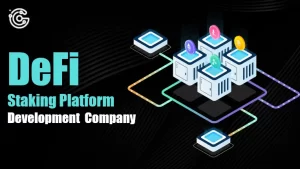Imagine earning money just by holding your crypto. No trading, no stress—just passive income flowing into your wallet. Sounds too good to be true? Well, that’s exactly what DeFi yield farming offers.
In the fast-evolving world of decentralized finance (DeFi), yield farming has become one of the most popular ways for crypto investors to maximize their earnings. By providing liquidity to decentralized exchanges (DEXs), users can earn rewards in the form of tokens, interest, and fees. This method has turned into a game-changer, making it an essential trend for 2025.
With the continuous growth of DeFi protocols, yield farming is not just a temporary trend—it’s a revolution in how people generate passive income in the digital economy. In this guide, we’ll break down everything you need to know about DeFi yield farming development, from how it works to the steps involved in creating a yield farming platform.
What is DeFi Yield Farming?
DeFi yield farming is a process where crypto holders lend or stake their assets in a DeFi protocol to earn rewards. Think of it as putting your money in a high-interest savings account, but instead of a bank, you’re depositing your crypto into liquidity pools.
One of the core concepts of yield farming is liquidity mining, where users provide liquidity to a DEX and, in return, receive governance tokens and a share of transaction fees. The funds users contribute are locked into smart contracts, which facilitate seamless transactions and reward distributions.
Role of Liquidity Providers (LPs)
Liquidity providers (LPs) are essential players in yield farming. They supply cryptocurrency pairs (like ETH/USDT) to liquidity pools, allowing traders to swap tokens efficiently. In return, LPs earn a portion of trading fees and additional token rewards, making yield farming a lucrative strategy.
The best part? You can reinvest your rewards, compounding your earnings over time. This is what makes DeFi yield farming a powerful passive income tool.
How Does DeFi Yield Farming Work?
Let’s break it down step by step:
Providing Liquidity – Users deposit cryptocurrency into a liquidity pool on a DEX like Uniswap or PancakeSwap. These pools help facilitate trading by ensuring there are always tokens available.
Earning Rewards – In return for supplying liquidity, users earn LP tokens and governance tokens. These rewards can be traded, reinvested, or staked for additional benefits.
Compounding Returns – Many farmers take their earned rewards and reinvest them into different pools to maximize their returns. This cycle of earning and reinvesting is what makes yield farming such a powerful strategy.
However, it’s not risk-free—impermanent loss, high gas fees, and security vulnerabilities can impact earnings. That’s why choosing the right DeFi platform is crucial.
Key Components of Yield Farming Development
Smart Contracts
Smart contracts are the backbone of yield farming. These self-executing contracts automate transactions, rewards, and liquidity management, ensuring that the process is trustless and efficient.
Liquidity Pools
Liquidity pools use Automated Market Makers (AMMs) to facilitate trading. Users deposit tokens into pools, enabling seamless swaps while earning transaction fees in return.
Governance Tokens
Yield farming platforms issue governance tokens that allow users to vote on protocol upgrades and earn additional rewards. Examples include UNI (Uniswap) and CAKE (PancakeSwap).
Staking Mechanisms
Users can stake their assets in farming pools to boost their rewards. This mechanism ensures long-term engagement and liquidity for DeFi platforms.
Benefits of DeFi Yield Farming
High Returns
Yield farming offers higher returns than traditional investment options. Early adopters of liquidity mining have seen triple-digit APYs in some cases.
Passive Income Generation
With yield farming, you can earn rewards without actively trading. Simply stake your assets and watch your earnings grow over time.
Decentralization & Transparency
Unlike banks or centralized exchanges, DeFi yield farming operates without intermediaries, giving users full control over their funds.
Liquidity Incentives
Yield farming boosts the liquidity of DeFi protocols, making trading faster, cheaper, and more efficient.
Challenges & Risks in Yield Farming
Impermanent Loss
When token prices fluctuate, LPs may end up with fewer assets than they initially deposited. This can offset yield farming rewards.
Smart Contract Vulnerabilities
Since DeFi platforms rely on smart contracts, hacks and exploits are a major risk. A single bug can lead to millions in losses.
High Gas Fees
Ethereum-based platforms often suffer from expensive transaction fees, making small-scale farming less profitable.
Market Volatility
Crypto prices are highly volatile, meaning the value of earned rewards can drop significantly overnight.
How to Develop a DeFi Yield Farming Platform
Planning & Research
Before starting development, conduct market research to understand user needs. Choosing the right blockchain (Ethereum, BSC, Solana, or Polygon) is also crucial.
Smart Contract Development
Secure and well-audited smart contracts are the foundation of any yield farming platform. They automate liquidity management and reward distribution without human intervention.
Liquidity Pool & Staking Mechanism
Developing AMM-based liquidity pools allows seamless token swaps, while a staking mechanism ensures long-term platform engagement.
Security & Risk Management
Security audits and multi-layer encryption are essential to protect user funds from hacks and exploits.
UI/UX Design & User Dashboard
An intuitive, mobile-friendly dashboard helps users track their earnings, referrals, and staking activities with ease.
Testing & Deployment
Before launching, thorough penetration testing and beta trials ensure the platform is bug-free and secure
Cost of DeFi Yield Farming Development in 2025
|
Development Aspect |
Estimated Cost |
|
Smart Contract Development |
$10,000 – $30,000 |
|
Frontend & Backend Development |
$20,000 – $50,000 |
|
Security Audits & Testing |
$5,000 – $15,000 |
|
Marketing & User Acquisition |
$10,000 – $40,000 |
|
Total Estimated Cost |
$50,000 – $150,000 |
Future Trends in DeFi Yield Farming (2025 & Beyond)
- Multi-Chain Yield Farming
Projects are now enabling cross-chain farming, allowing users to farm across multiple blockchains seamlessly.
- AI-Powered Yield Optimization
AI is being used to analyze market trends and allocate liquidity more efficiently, boosting overall returns.
- NFT Yield Farming
Some DeFi platforms now allow users to stake NFTs in liquidity pools, earning rewards based on NFT rarity and utility.
- Regulatory Developments
With the rise of DeFi, governments are introducing regulations that may impact yield farming projects. Staying compliant will be key for future platforms.
Conclusion
DeFi yield farming has become one of the most lucrative passive income strategies in the crypto space. As DeFi adoption continues to grow, businesses looking to develop a secure, scalable, and profitable yield farming platform should act fast.
If you’re planning to build a DeFi yield farming platform, partnering with an experienced DeFi development company is essential.
Ready to launch your own DeFi yield farming platform?
Connect with Coin Developer India today!
Quick Contact with us:
Call/Whatsapp: +91 70 14607737
Mail ID: [email protected]








